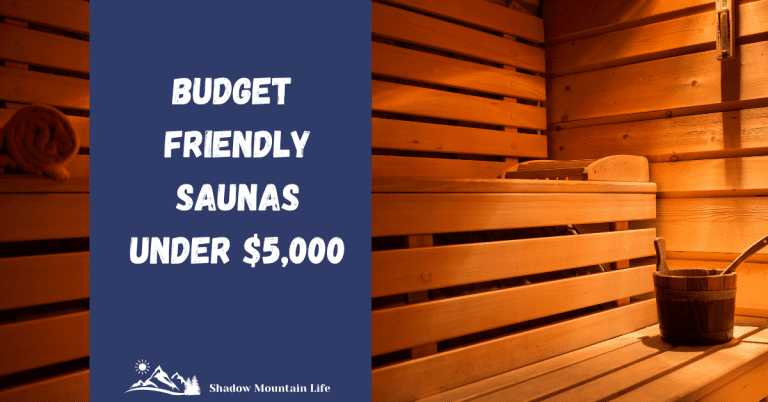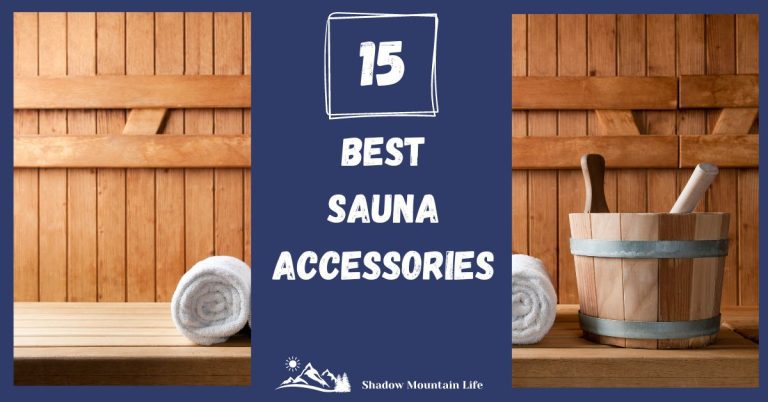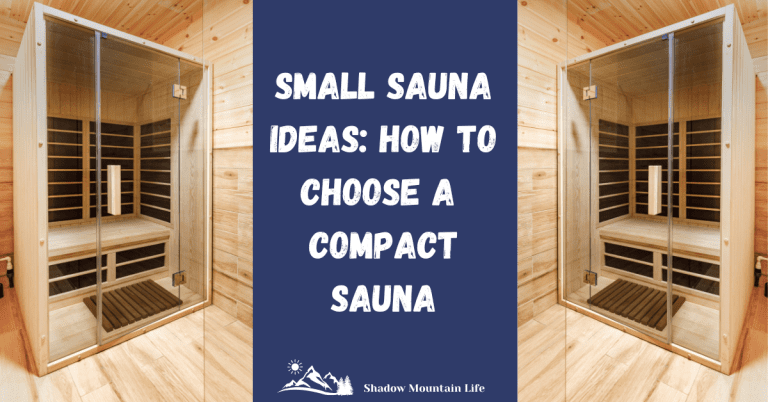The Comprehensive Sauna Guide For Beginners: Types, Benefits, and How to Use a Sauna
Medical Disclaimer: We are not doctors. The health information in the article is for informational and educational purposes only. Please consult your doctor or other healthcare professional when making medical decisions.
Affiliate Disclaimer: We may make a commission if you purchase something through our links. Thank you!
Introduction: Why Sauna?
Imagine stepping into a warm, enveloping space that melts away stress, rejuvenates your body, and transforms your health! Saunas have been a wellness secret for centuries, with cultures around the world embracing their incredible therapeutic potential. Read our comprehensive sauna guide for beginners and discover how to benefit from a sauna yourself!
Saunas have been around for literally thousands of years. The Finns, who invented modern sauna culture, have been using these magical heated rooms since around 7000 BC. Wild, right? These weren’t just places to relax; they were legit multi-purpose spaces where everything from healing the sick to giving birth happened. Talk about versatile!
Here’s a fun fact: In Finland, there are approximately 3.2 million saunas for a population of 5.5 million people. That means there’s basically a sauna for every other person! It’s not just a luxury – it’s a way of life.
Different cultures have their own spin on heat therapy too. While Finns have their traditional wood-burning dry saunas, Russians have their banyas, which are these steam-heavy rooms that feel totally different. Native Americans had sweat lodges for spiritual and healing purposes.
The basic principle of saunas is pretty simple. You’re creating an environment where your body experiences intense heat, which triggers some pretty amazing physiological responses. Your heart rate goes up, blood vessels dilate, and your body starts this incredible cooling mechanism (sweating) that’s like an internal workout without actually moving. The first time I really understood how saunas work, I was like, “Wait, so sitting still can be this good for me?”
But here’s something most people don’t realize – saunas aren’t just about sweating. They’re a complex interaction between heat, humidity, and your body’s incredible adaptive mechanisms. Your metabolism speeds up, your immune system gets a boost, and you’re releasing all these feel-good hormones. Saunas provide a natural high that doesn’t involve anything illegal!
Of course, I learned all this the hard way. My first few sauna experiences were not the greatest. I didn’t understand how much hydration I needed, how long to stay in, and definitely didn’t realize you’re supposed to cool down properly afterwards. Instead, I would end up with a headache and immediately hop into a hot shower. Don’t be like younger me. Drink water, start with shorter sessions when you use the sauna, and take some time to cool down afterwards.
The cool thing is that science is now catching up with what traditional cultures have known forever. Research is showing that regular sauna use might help with everything from cardiovascular health to stress reduction.
It’s not just a luxury – it’s potentially a legitimate health intervention and more and more people are realizing this. Just in the past couple of months two major gyms in my town put in saunas and are now advertising them like crazy to their members.
So whether you’re a total newbie or someone who’s been curious about saunas, just know this: You’re not just stepping into a hot room. You’re participating in a centuries-old tradition of human wellness, adaptation, and some seriously awesome body hacking!
Types of Saunas: Exploring Diverse Heat Experiences
As you learn more and more about saunas, you will realize there are a lot of options out there that leave you with the same result.

Let’s start with the gold standard of saunas – the traditional Finnish wood-burning sauna. These are the real deal, my friends. Imagine a small wooden room heated by a fire-breathing beast of a stove, with rocks that get so hot they practically glow. The Finns call the steam created when you throw water on these rocks “löyly”.
Electric saunas are like the modern cousin of the wood-burning type. They’re way more convenient, especially if you don’t want to chop wood or manage a fire every time you want to sauna. There are various sizes and types of electric sauna heaters, and these saunas are typically found in homes, hotels, and fitness centers. They’re basically the Toyota Camry of saunas – reliable, straightforward, and gets the job done without too much drama.
Now, infrared saunas? Total game-changer. These saunas work differently – instead of heating the air, they directly heat your body. The temperatures in infrared saunas don’t normally go above 140 degrees Fahrenheit. You may wonder how could something that is cooler than a traditional sauna actually do anything health wise? Spoiler alert: it does PLENTY. Infrared options are amazing for people who can’t handle the intense heat of traditional saunas, and yet they can still reap the benefits of a traditional sauna.
Steam rooms are a whole different vibe and not really considered a sauna at all. They are usually tile-covered rooms and are incredibly humid. It will feel like you are in a tropical rainforest. They’re popular in spas and gyms, and they’re great if you love very humid air.
Portable saunas have become an option for folks who want the sauna experience but don’t have space for a full setup. These are basically personal sauna that look like a camping tent or blanket. They’re perfect for apartment dwellers or people who travel a lot and want to keep up their wellness routine. Sauna tents, especially, are great for off-grid adventures. I mean, what could be better than a backcountry ski and a hot sauna before bed?
Temperature-wise, these saunas are all over the map. Traditional Finnish saunas can hit around 80-100°C (176-212°F), while infrared saunas typically run cooler, around 45-60°C (113-140°F). Steam rooms usually hang out around 40-50°C (104-122°F) with nearly 100% humidity. Each type offers a different experience and potential health benefit.
Choosing a sauna isn’t one-size-fits-all. It depends on your health goals, personal comfort, and honestly, how much heat you can handle. Some people love the intense dry heat of a Finnish sauna, while others prefer the gentle warmth of an infrared setup.
My biggest piece of advice? Try them all if you can. Each sauna type is like a different flavor of wellness, and you might be surprised at what works best for your body. See which gyms or wellness spas offer which type of sauna in your area and give them a try.
Health Benefits of Sauna Therapy
Saunas offer a tremendous variety of benefits.
Cardiovascular health is where saunas seriously shine. I’m talking about some scientific research that suggests regular sauna use can be as good for your heart as moderate exercise. One Finnish study found that guys who used saunas 4-7 times a week had a 63% lower risk of sudden cardiac death. That’s not just a small improvement – that’s a life-changing statistic.
Stress reduction isn’t just some marketing lingo with saunas. When you’re in that heated space, your body releases a flood of endorphins and reduces cortisol levels. Try it the next time you are heading home from a stressful work week!
Muscle recovery is another amazing benefit that athletes are catching onto. The heat increases blood circulation, which helps repair muscle tissue faster. Professional athletes have been using this as a secret weapon for years. After intense workouts, a sauna session can help reduce muscle soreness and speed up recovery time.
Metabolism and weight management get a serious boost too. Your body works hard to cool itself down in a sauna, which means you’re burning calories just by sitting still. It’s not a replacement for exercise, but it’s definitely a cool supplement to your fitness routine.
Skin health is something most people don’t think about when considering a sauna. The intense sweating helps clear out your pores, increases collagen production, and can improve overall skin tone. I’ve noticed my skin looking cleaner and clearer since incorporating regular sauna sessions.
The immune system boost from a sauna is for real. The controlled heat stress actually stimulates the production of heat shock proteins and white blood cells. Translation? You’re basically training your immune system to be more resilient. During cold and flu season, this can be so good.
Sleep quality is another unexpected benefit. The post-sauna drops in body temperature mimics what happens naturally when you’re preparing for sleep.
A few critical warnings: If you have heart conditions, are pregnant, or have certain medical issues, always – and I mean ALWAYS – consult with your healthcare provider first. Saunas are powerful, and they’re not for everyone.
Choosing the Right Sauna for Your Needs
Choosing a home sauna takes some careful consideration and planning. There are many options, and each one comes with its own set of pros and cons.
Budget
Budget is the first thing you need to consider. Saunas can range from a cheap sauna blanket from a big box store to “could buy a small car” expensive. Traditional Finnish-style wood saunas can run you anywhere from $3,000 to $30,000 for a home installation. Infrared saunas can be slightly cheaper depending on the type and size you go with. Portable options will be your cheapest bet with some sauna tent packages running around $2,000. But don’t just look at the upfront cost. Factor in electricity, maintenance, and potential installation expenses as well.
Space
Space is another critical factor that most people need to really look into. Measure, measure, and measure again! Portable infrared saunas can be as compact as a small closet, while traditional wood-burning saunas might require a dedicated outdoor space or significant indoor real estate.
Indoor saunas need proper ventilation, electrical work, and potentially waterproofing. Outdoor saunas require weatherproofing, appropriate electrical outlet and a solid foundation
Personal Health
Your personal health conditions are super important. People with cardiovascular issues, pregnancy, or certain chronic conditions need to be extra careful. Infrared saunas tend to be gentler and might be better for those with heat sensitivity. Always check with your healthcare provider before making a significant sauna investment.
Type of Material
Material matters more than you’d think. Wood types can impact the entire sauna experience. Cedar is amazing for its natural resistance to moisture and that incredible smell. Many saunas are also made from heat-treated Thermowood. Each material has its own vibe and maintenance requirements.
Electrical
Electrical considerations are no joke. Most home saunas require a dedicated 220-240V electrical circuit. If you’re not an electrician (and let’s be real, most of us aren’t), you’ll need professional installation. Some smaller infrared units can plug into standard outlets, but the good ones typically need special wiring.
Maintenance
Maintenance is something most people forget about until it’s too late. Wood saunas need regular sealing, cleaning, and potential wood treatment. Electric saunas require periodic heating element checks. Infrared panels might need occasional cleaning or replacement.
Standard or Portable Sauna
Portable vs. built-in is a big decision. Portable saunas are great for renters or people who move frequently. Built-in saunas add serious property value and provide a more authentic experience. I’ve seen people convert entire bathroom spaces into sauna sanctuaries – and it looks incredible.
My biggest piece of advice? Don’t just buy the first sauna you see. Research, ask questions, and most importantly, understand your personal wellness goals and be clear on what you want. Are you looking for muscle recovery? Stress reduction? High heat? Lower heat?
Consider trying out different saunas at local gyms, spas, or wellness centers before making a purchase. It’s like test-driving a car, but for your health. Some fancy gym memberships even include sauna access, which can be a budget-friendly way to explore different types.
Sauna Safety and Best Practices
I didn’t feel great after my first few sauna sessions. I remember having a headache and feeling uncomfortable. Looking back, I was seriously dehydrated!
Hydration
I’ve learned that hydration is everything. And I mean EVERYTHING. Before you even think about stepping into a sauna, you need to be drinking water like it’s your job. We’re talking at least 16-20 ounces of water before your session, and another 16-20 ounces after. Dehydration in a sauna is no joke – it can lead to dizziness, headaches, and some seriously scary health risks.
Experiment with coconut water, electrolyte drinks or water with lemon squeezed in. Personally, I like 1-2 glasses of water with half a packet of sugar free Liquid IV mixed in after a sauna.
Duration
Duration is critical. Most experts recommend starting with 10–15-minute sessions, especially if you’re a beginner. Cool off and hydrate between sessions and don’t go more than 2 sessions to start. If you feel dizzy, lightheaded, or uncomfortable, get out immediately.
Sauna Wear
If you’re in a public sauna, always bring a towel to sit on and wear appropriate swimwear or loose, breathable clothing. In your own sauna, it’s up to you!
Temperature Ranges
Temperature is not a competition. Different saunas have different heat ranges. Traditional Finnish saunas can hit 80-100°C (176-212°F), while infrared saunas run cooler at 45-60°C (113-140°F). Just because you can handle high heat doesn’t mean you should push your limits. Don’t try to be “tough” and end up with heat exhaustion.
Medical Considerations
Medical considerations are super important. If you have any of these conditions, talk to your doctor before sauna use:
• Heart conditions
• Low or high blood pressure
• Pregnancy
• Recent surgery
• Certain medications
• Diabetes
• Chronic conditions
Cool Down
Cool down is just as important as the sauna session itself. After your sauna, take time to cool down gradually. Some cultures practice contrast therapy – alternating between hot sauna and cold shower, cold plunge or even snow.
Eating and Drinking
Eating and drinking have specific guidelines. Avoid heavy meals right before a sauna session. Alcohol is a huge no-no – it increases dehydration risk and can be dangerous in high heat. Light, easily digestible snacks and plenty of water are your best friends.
Hygiene
Personal hygiene is crucial. Always shower before entering a sauna. Bring a clean towel to sit on in public saunas. If you’re using a home sauna, regular cleaning is essential to prevent bacteria growth.
Warning signs to Watch For
• Extreme dizziness
• Nausea
• Chest pain
• Difficulty breathing
• Extreme weakness
• Unusual heart rhythms
Exit the sauna immediately if you experience any of these. It’s also a good idea to let someone know you are in the sauna before heading in.
Saunas are incredible for wellness, but they’re not a joke. Treat them with respect, prepare properly, and always prioritize your safety.
Advanced Sauna Techniques and Experiences
As you get more comfortable in the sauna and you understand adequate hydration and recovery, there are a few more things you can add into your sauna routine if you wish.

Cold Plunging
Cold plunge tubs have become more mainstream in the past few years and provide a wonderful way to add contrast therapy to your sauna routine. Basically, you are purposely moving between extreme heat and freezing cold – sounds nuts, right? But it’s actually great for your body. The technique involves alternating between the intense heat of a sauna and a cold shower, ice bath, or even rolling in snow (if you’re brave enough).
Professional athletes swear by this method for recovery. My first attempt was like a full-body shock to my system when I tried out our cold plunge. However, after the initial shock passed, I was able to stay in longer than I expected, and the sauna afterwards felt wonderful!
Mindfulness/Prayer
Sauna meditation or prayer is something most people don’t even consider, but it’s a very important practice. It’s not just about sitting in silence; it’s about using the stillness of the environment to practice serious contemplation or prayer. As your body is sweating out toxins, your mind and spirit can detox from unhealthy emotions and toxic thinking at the same time.
Aromatherpy
Aromatherapy in saunas is a fragrant addition to your sauna. Different essential oils can completely transform your experience. Eucalyptus for clearing respiratory systems, lavender for relaxation, peppermint for energy – it’s like a sensory upgrade to your heat therapy.
Pro tip: Don’t throw the oil on the sauna stones alone. Mix a few drops into your bucket of water to dilute and then when you are ready for some steam, throw a few ladlefuls.
Venik
Herbal steam techniques are big in traditional cultures. In Russian banyas and Finnish saunas, people use bundles of birch or oak branches called “venik” to gently beat the skin. It sounds crazy, but it’s actually an incredible way to improve circulation, stimulate the skin, and enhance the detoxification process.
Music and Sound
Music and sound therapy are an emerging trend in sauna experiences. Some high-end wellness centers are experimenting with specific sound frequencies and music during sauna sessions. Low-frequency sounds can help deepen relaxation and enhance the meditative aspect of heat therapy. Many saunas come with built in stereo systems and Bluetooth capabilities.
Breathwork
Breathwork techniques can totally change your sauna game. Different breathing patterns can help you manage the heat, reduce stress, and enhance the overall therapeutic experience. Box breathing, alternate nostril breathing, and deep diaphragmatic breathing can turn a simple sweat session into a profound mind-body experience.
Hot Yoga
Mindful movement in saunas is becoming more popular. Some wellness centers offer gentle yoga or stretching sessions in infrared saunas. It’s not about intense workout – it’s about using the heat to enhance flexibility and body awareness.
The important thing is to engage with the experience and enjoy the sauna. Breathe intentionally. Pay attention to how your body feels. Use the time for mental clarity, physical recovery, or just pure relaxation. Choose all or just a few of the suggestions above to maximize the benefits of your sauna.
Conclusion
Saunas are more than just a wellness trend – they’re a holistic approach to health that has stood the test of time. By understanding the different types, benefits, and best practices, you can transform your health routine and unlock incredible potential for physical and mental rejuvenation.
Call to Action: Ready to start your sauna journey? Consult with a healthcare professional, explore local facilities, or consider a backyard or in-home sauna to experience the transformative power of heat therapy.
Sauna FAQ: Your Burning Questions Answered
Frequently Asked Questions About Sauna Use
Q: How often should I use a sauna?
Most health experts recommend 3-4 sessions per week, with each session lasting 15-30 minutes. However, individual tolerance varies. Beginners should start with shorter, less frequent sessions and gradually build up. Listen to your body and consult with a healthcare professional if you have any underlying health conditions.
Q: Is it safe to use a sauna every day?
For most healthy adults, daily sauna use can be beneficial. The famous Finnish studies showed that 4-7 sessions per week provided the most significant health benefits.
Q: How long should a typical sauna session last?
For beginners:
- Start with 10-15 minutes
- Gradually increase to 20-30 minutes
- Take breaks and hydrate
- Exit immediately if you feel dizzy or uncomfortable
Professional athletes and experienced users might extend sessions to 45 minutes, but this requires careful preparation and excellent physical condition.
Q: Can saunas help with weight loss?
Saunas can support weight loss indirectly by:
- Boosting metabolism
- Burning 300-600 calories per session
- Reducing water weight
- Supporting muscle recovery
However, saunas are not a primary weight loss tool. They should complement a balanced diet and regular exercise, not replace them.
Q: What should I wear in a sauna?
Recommendations vary by culture and location:
- Traditional Finnish saunas: Often nude with a towel for sitting
- Public gyms: Appropriate swimwear or loose, breathable clothing
- Home saunas: Minimal, breathable clothing or towel
- Always bring a clean towel to sit on
- Avoid heavy, moisture-trapping fabrics
Q: Are saunas good for skin?
Absolutely! Saunas can improve skin health by:
- Opening pores
- Increasing circulation
- Promoting collagen production
- Helping remove toxins through sweating
- Potentially reducing acne and improving overall skin tone
Q: Can children use saunas?
Recommendations vary:
- Most experts suggest children over 12
- Shorter, supervised sessions
- Lower temperatures
- Constant hydration
- Individual tolerance differs
- Parental supervision is crucial







